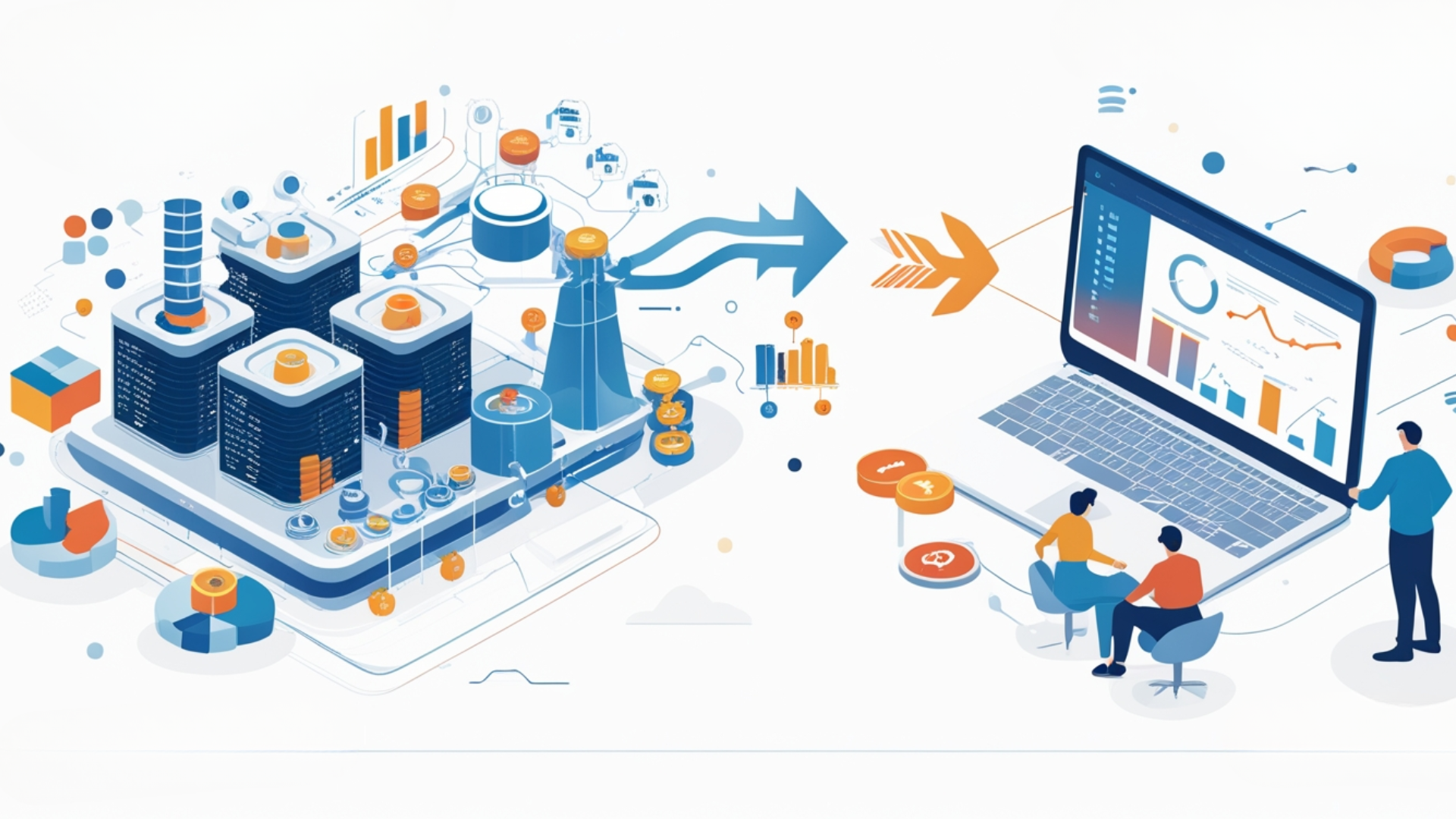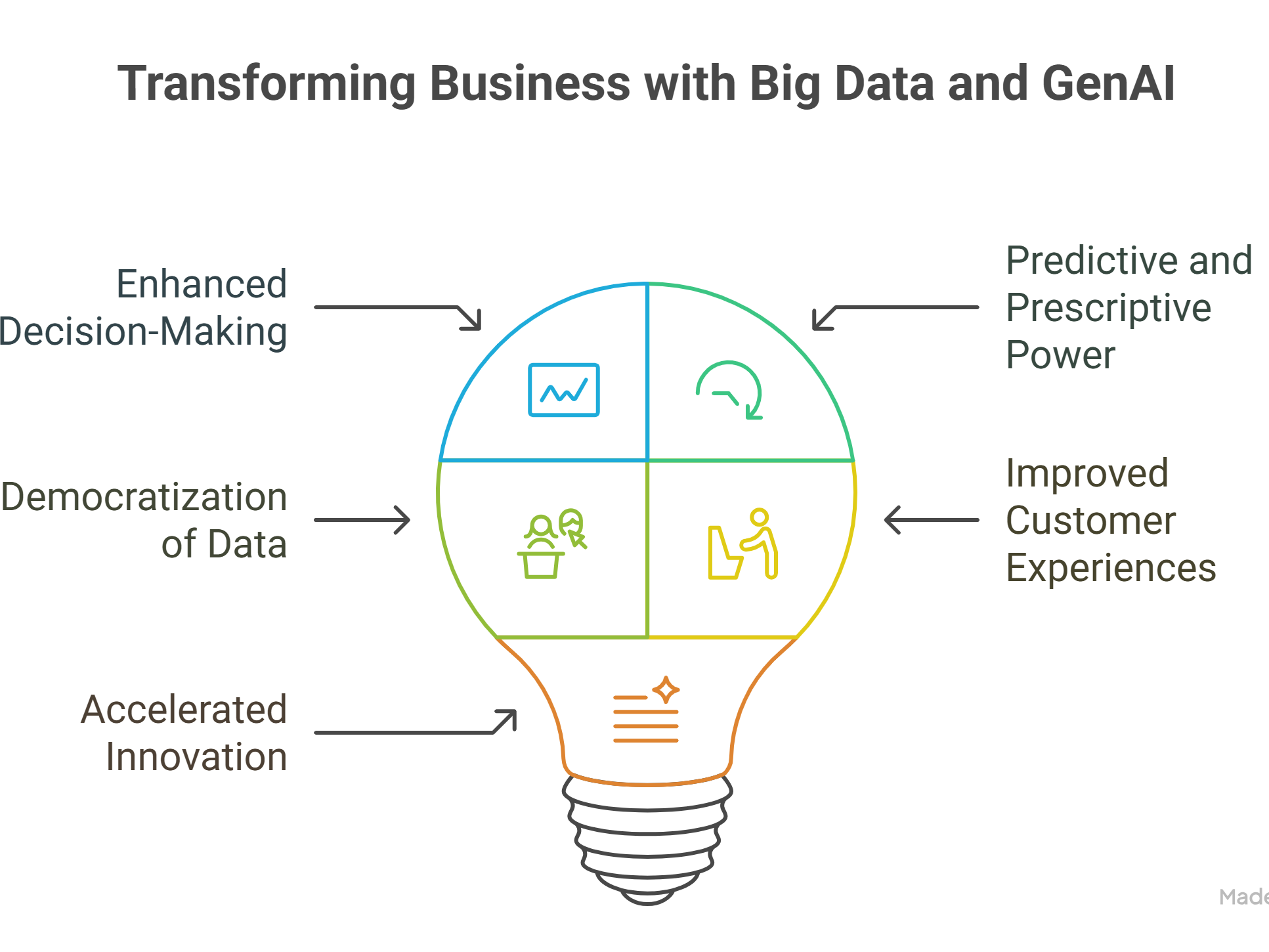
Big Data Generative AI Analytics represents the evolution of enterprise intelligence where massive datasets are combined with the creative capabilities of Generative AI models. Traditionally, organizations used their data for descriptive and predictive analytics. However, with the emergence of advanced Generative AI systems, the scope of analytics is no longer restricted to static dashboards. Instead, enterprises today can obtain narrative insights, generate synthetic datasets, and even run future simulations. Consequently, Big Data Generative AI Analytics is becoming a cornerstone of digital transformation across industries.
Moreover, companies now face dynamic environments where decision-making speed directly impacts competitiveness. Therefore, integrating Big Data with Generative AI provides not only deeper understanding but also agile intelligence. For this reason, many businesses are aligning their strategies around GenAI-powered data ecosystems.
Understanding Big Data and Generative AI
What is Big Data?
Big Data refers to information collections so large and diverse that conventional tools cannot process them effectively. These datasets are defined by the well-known 5 V’s—volume, variety, velocity, veracity, and value. Because of these attributes, organizations struggle to manage Big Data efficiently. Nevertheless, when analyzed with the right technologies, this data reveals powerful trends.
What is Generative AI Analytics?
Generative AI leverages models such as Large Language Models (LLMs) and Generative Adversarial Networks (GANs) to create new output. Unlike predictive algorithms that focus only on forecasting based on past data, Generative AI can generate responses, reports, and synthetic datasets. As a result, instead of manually coding statistical queries, decision-makers can converse with AI to derive insights.
Why Merge Big Data with GenAI?
When Big Data infrastructures are combined with Generative AI models, analytics shifts from static to dynamic. For example, traditional dashboards may highlight sales drops; however, GenAI can narratively explain why the drop occurred and simulate corrective strategies. Furthermore, executives can simply query data in natural language and immediately receive accurate, contextualized insights. In short, the merger improves speed, democratizes data interpretation, and accelerates innovation.
Benefits of Big Data Generative AI Analytics

Enhanced Decision-Making
By leveraging Big Data with GenAI, organizations gain real-time narrative insights. Instead of interpreting raw graphs, leaders now receive natural-language recommendations. As a result, decision-making becomes easier and faster.
Predictive and Prescriptive Power
While predictive analytics identifies future events, Generative AI extends this by suggesting corrective actions. Therefore, companies do not just know “what may happen” but also “what should be done.”
Democratization of Data
In the past, analytics required advanced technical skills. However, GenAI Analytics enables any business user to interact directly with enterprise data. Consequently, data analysis becomes accessible across all job functions.
Improved Customer Experiences
Customers today demand personalization. Thanks to Generative AI, businesses can analyze sentiment and behavior, then generate tailored recommendations. Moreover, AI-driven conversational agents further enhance user engagement.
Accelerated Innovation
One of the most promising advantages of GenAI Analytics is synthetic data creation. In situations where data is limited, sensitive, or unavailable, AI models generate realistic alternatives. Consequently, organizations can innovate faster without depending exclusively on real-world data.
Use Cases Across Industries
Financial Services
Financial institutions operate in complex environments with fluctuating risks. With Generative AI:
- Fraud detection becomes stronger since GenAI simulates suspicious activities.
- Regulatory compliance reporting happens automatically in natural language.
- Personalized investment insights improve customer satisfaction.
Most importantly, banks reduce operational risks while serving customers faster.
Healthcare
The healthcare sector handles massive amounts of unstructured records. Consequently, GenAI delivers major improvements:
- It generates patient summaries from clinical notes.
- Outbreak modeling becomes more accurate.
- Rare disease datasets can be synthesized, fueling research.
Therefore, diagnosis improves and life-saving insights emerge sooner.
Manufacturing
Modern manufacturing plants rely on sensors, IoT devices, and process data. Consequently, Big Data Generative AI Analytics is transforming the industry by:
- Driving predictive maintenance, reducing downtime.
- Enhancing digital twins for process simulation.
- Supporting demand forecasting with real-time updates.
As a result, production becomes more efficient, sustainable, and cost-effective.
Retail
Retailers constantly face consumer demand shifts. With Big Data Generative AI Analytics:
- Inventory levels are forecasted dynamically.
- Marketing campaigns are adjusted automatically from sentiment analysis.
- Synthetic customer data enables safe testing of strategies.
Hence, retailers reduce waste, maximize sales, and achieve customer loyalty.
Smart Cities
Urban planning generates continuous Big Data from sensors and IoT-enabled infrastructure. Consequently, GenAI can contribute by:
- Forecasting energy demands.
- Improving traffic management.
- Providing AI-generated policy recommendations for sustainable development.
Therefore, cities become more responsive, efficient, and citizen-friendly.
Case Study: Retail Transformation through Big Data Generative AI Analytics
Background:
A global retailer faced challenges balancing supply and demand while ensuring customer satisfaction. Traditional forecasts failed because they relied on historical averages without real-time data.
Solution:
The company deployed a Big Data Generative AI Analytics platform. Consequently, it aggregated:
- Sales and logistics data,
- IoT-based shelf sensors, and
- Social media customer feedback.
Generative AI converted this data into actionable insights. Moreover, synthetic data simulated future trends such as festival demand spikes. Importantly, local store managers accessed AI-generated, human-readable summaries instead of technical dashboards.
Results:
- Forecasting accuracy improved by 30%,
- Inventory waste reduced by 22%, and
- Store managers reported an 80% increase in decision-making confidence.
Consequently, the company transformed analytics into a growth enabler while reducing operational costs.
Challenges of Big Data Generative AI Analytics
Although the benefits are significant, challenges still persist.
- Data Privacy Risks: Sensitive data must comply with laws such as GDPR and HIPAA. Otherwise, organizations face penalties.
- Bias in AI: Generative AI may produce false or biased results if data quality is poor.
- High Costs: Processing at scale requires expensive cloud and GPU infrastructures.
- Skill Gaps: Employees need training to adopt AI-driven approaches.
- Scalability: Without proper architecture, systems may fail under data surges.
Therefore, proper governance, infrastructure planning, and human oversight are essential.
Best Practices for Implementation
To succeed with Big Data Generative AI Analytics:
- Establish strong data governance to assure data quality and compliance.
- Adopt cloud-native scaling for elasticity.
- Incorporate human-in-loop systems to balance automation with accountability.
- Train employees in prompt engineering to maximize AI output accuracy.
- Measure ROI continuously to decide when to scale further.
As a result, organizations maximize outcomes while minimizing risks.
Future Trends
- Real-Time Analytics: Streaming pipelines will enable continuous insights.
- AI Assistants for Enterprises: Conversational dashboards will become mainstream.
- Standardized Synthetic Data: Regulatory frameworks will ensure safe and ethical use.
- Security Integration: GenAI analytics will enhance cybersecurity by identifying evolving threats.
- Advanced Digital Twins: From factories to entire cities, intelligent twins will simulate multiple scenarios.
Therefore, the integration of Big Data and Generative AI will continue reshaping entire sectors.
FAQs
What is Big Data Generative AI Analytics?
It is the fusion of massive Big Data processing with Generative AI models that create narrative insights, synthetic data, and actionable decisions.
How does Generative AI improve Big Data analytics?
Generative AI enhances Big Data analytics by converting raw patterns into plain-language narratives, generating synthetic datasets, and simulating real-world scenarios.
Which industries use Big Data Generative AI Analytics?
Industries including finance, healthcare, manufacturing, retail, energy, and government are embracing GenAI analytics to improve decision-making.
What risks are associated with Generative AI in analytics?
The main risks involve biased results, privacy violations, high infrastructure costs, and scalability challenges.
Can synthetic data replace real customer data?
Not entirely. However, synthetic data helps emulate real-world patterns without privacy violations, making it ideal for testing and training.

